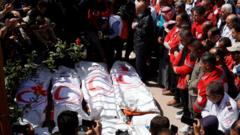In a striking development, video footage has surfaced seemingly undermining the Israeli Defense Forces' (IDF) narrative surrounding the deadly shooting of emergency workers in Gaza. On March 23, a convoy of ambulances and a fire truck was attacked, resulting in the deaths of 15 rescue personnel, including members from the Palestine Red Crescent Society (PRCS).
The footage, which the New York Times reported was captured by a PRCS paramedic who was among the fatalities, shows the marked emergency vehicles navigating in darkness, complete with headlights and flashing emergency lights, prior to the attack. In contrast, the IDF's initial depiction suggested that "several uncoordinated vehicles" approached their troops suspiciously without proper signaling, prompting the military to open fire.
A surviving paramedic, Munther Abed, made a statement to the BBC asserting that all their lights were operational, which should have unmistakably identified the vehicles as ambulances. He insisted, “All crews are civilian. We don’t belong to any militant group. Our main duty is to offer ambulance services and save people’s lives. No more, no less.”
Meanwhile, Israel's Foreign Minister, Gideon Saar, reiterated the IDF's version of events, denying random attacks on ambulances. However, mounting pressure for accountability has arisen. Dr. Younis Al-Khatib, the President of the PRCS, poignantly recalled the last words of a team member before he was shot—expressing his desire solely to help others.
This video was discovered on the paramedic's phone after his body was found in a shallow grave alongside those of other emergency workers, raising profound concerns about the treatment of medical personnel in conflict zones. With one paramedic still unaccounted for, the call for an independent investigation into this incident continues to gain traction among international organizations and advocates.
The footage, which the New York Times reported was captured by a PRCS paramedic who was among the fatalities, shows the marked emergency vehicles navigating in darkness, complete with headlights and flashing emergency lights, prior to the attack. In contrast, the IDF's initial depiction suggested that "several uncoordinated vehicles" approached their troops suspiciously without proper signaling, prompting the military to open fire.
A surviving paramedic, Munther Abed, made a statement to the BBC asserting that all their lights were operational, which should have unmistakably identified the vehicles as ambulances. He insisted, “All crews are civilian. We don’t belong to any militant group. Our main duty is to offer ambulance services and save people’s lives. No more, no less.”
Meanwhile, Israel's Foreign Minister, Gideon Saar, reiterated the IDF's version of events, denying random attacks on ambulances. However, mounting pressure for accountability has arisen. Dr. Younis Al-Khatib, the President of the PRCS, poignantly recalled the last words of a team member before he was shot—expressing his desire solely to help others.
This video was discovered on the paramedic's phone after his body was found in a shallow grave alongside those of other emergency workers, raising profound concerns about the treatment of medical personnel in conflict zones. With one paramedic still unaccounted for, the call for an independent investigation into this incident continues to gain traction among international organizations and advocates.



















